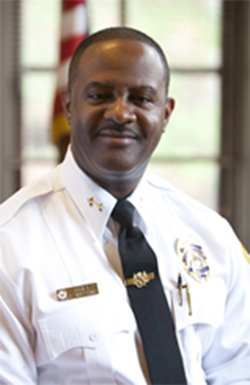Serious Crime Down at UMB, Year-End Stats Show
Led by robberies, which dropped nearly 60 percent, serious crime at UMB fell in 2015, according to recently released statistics from the UMB Police Force.
Robberies, incidents that involve violence or the threat of violence, dropped from 12 in 2014 to five in 2015. Aggravated assault, which includes the use of a weapon, dropped from eight in 2014 to seven in 2015, and simple assault fell from 16 to 15 in 2015.
Antonio Williams, MS, police chief and associate vice president of public safety at UMB, was encouraged by the 2015 statistics.
“I basically mandated to our department that we have to reduce violent crime on the campus. So I was certainly encouraged,” Williams says. “I’m not happy yet, but the numbers are moving in the right direction.”
Asked about the reasons for the huge drop in robberies, he cited improved strategies, increased visibility of the UMB Police Force, and especially making additional riding escorts available.

Antonio Williams, MS, UMB Chief of Police, Assoc. VP of Public Safety
“Back in October 2014, we added a second van to the riding escort program,” Williams recalls. “It was my desire that anyone who wants a ride can get a ride. If people don’t feel comfortable walking around in the evening, it was my desire that people don’t have to walk around in fear. When it gets dark, get a ride [by calling 6-6882], and it really helped.”
Additional police personnel and expanded boundaries and times also strengthened the riding escort, which served 13,621 riders in 2015, twice that of the year before.
Murders, rapes, and arsons remained at zero in UMB’s year-end crime statistics. Stolen vehicles fell from three in 2014 to one in 2015. But not all the numbers were favorable. Due to an uptick in thefts (from 68 in 2014 to 79 in 2015) overall crime incidents were the same in 2014 as in 2015 (109 incidents each year).
Williams said mobilizing greater forces outside, especially after the unrest in April, and less in the buildings themselves, which is where thefts occur, contributed to the increase.
“We have limited resources and we took more of those resources and put them outside because people were telling me, ‘Chief, I don’t feel safe walking in this location or that location.’ We try to be responsive to our community. I’m concerned about thefts, like all crime. Now that violent crime is down, people are more concerned about other types of issues, like theft or crossing the street or street signs that have fallen down.”
Lowering thefts will be part of an anti-theft initiative Williams will be rolling out in the months ahead. For now, he offers the following suggestions.
“It’s a two-fold thing. Part of it is what can the community do and then what can the Department of Public Safety do. I believe we still need to emphasize the message of people keeping valuables in their possession. Don’t leave valuables unattended. Also take advantage of programs like Operation Identification, where laptops and larger items can be engraved. And resources like CITS [Center for Information Technology Services], which can provide information about laptop tracking software, such as LoJack for computers.”
Deputy Chief Milland Reed, MS, spoke at Dr. Perman’s November Q&A about how new policing strategies, with an emphasis on employees’ arrival and departure times, have been effective. Williams hopes to grow on those successes.
"We look to break something out every year,” he said. “We certainly try to be accommodating to our community. So we’ll be breaking something out shortly to help people have some tools and some avenues to help take part in reducing thefts around the campus.”
Though thefts went up in 2015, the 79 incidents pale beside the 139 and 120 thefts on campus in 2012 and 2013, respectively. Is Williams surprised by the improving numbers, especially in a year when there was civil unrest and rising crime in the city?
“No. I was not surprised,” he says. “We have a track record here of being rather successful at keeping some of the things that happen around the city, in general, away from our campus. Some of that is due to the efforts that we put in as a public safety department. I believe some of that can be attributed to our community members being more cognizant, as well, and then there’s also another piece that I hear from time to time on the street, that certain people feel we have a good reputation as a University and as a public safety department, and that contributes to the notion that it’s not so easy to commit crimes on this campus.”
Williams is looking forward to crime stats dropping further as well as to improvements to the police station itself.
“We got approval from the regents to complete our renovation project next door at 222 N. Pine St. That’s going to involve building a brand new communications center, which should open in 2017. There’s also going to be a new emergency operations center.”
Williams also is very proud of his police force.
“I would certainly say that the dedication and commitment of not just the sworn people, but the entire department, really helped improve the conditions on the campus,” says Williams, who just hired three lieutenants to bolster his force. “It’s a holistic approach. People see the officers on the street, some of the security people, but it’s a combination. Also the communications people and the administrative staff. They’re critical, because they’re the ones that most of the public interacts with. It took a combined effort of the entire department to get the results that we have, but also to take us forward to improve, and we will improve.”


